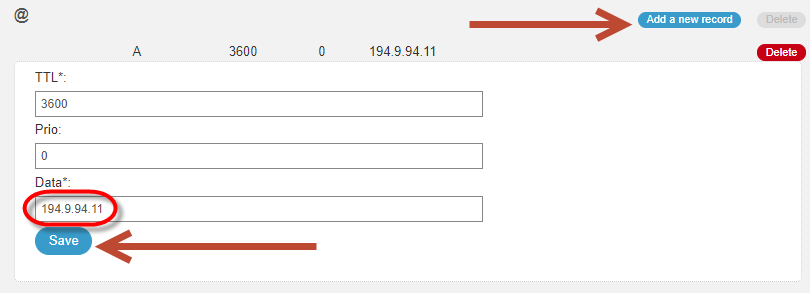To create an A or CNAME connection but wanting to keep email support with us, you can make the connection in our DNS editor. You can find this in the customer zone by clicking on the domain in question and then click on the blue button “DNS Editor“.
Inside the DNS editor you will find two sub domains with the names “@” and “www“. These are called “naked domains” ie the domain without www (or other sub domain) and with www (eg www.domenetmitt.no).
Change of value in existing DNS-record
To switch existing A-record to another IP address, it’s easiest to click on the IP address, edit (by clicking on “add a new record“) and save it. It’s the same if you’re replacing an existing CNAME record to another host name.

Changing type of connection
Instead, replace a connection from A to CNAME or vice versa, then delete the first link (Red button “Delete” to the right of the record value).
Then click the blue “Add a new Record” button to the right of the sub domain. The following guidelines apply:
- Type: Here you choose which type of address you want to connect to. If you want to connect to an IP address (Number series), “type” must be “A“. If you want to connect to another host name (domain name), select “CNAME” for the main domain (eg yourdomain.com) but only for sub domains (eg, subdomain.yourdomain.com). This is because of how the rules for DNS settings are specified.
- TTL: Here you usually write “3600” or if you have multiple records on the sub domain, same TTL as you have used for the records above.
- Data: Here you add the address to which your domain name should be connected towards. This may be an IP address if you have selected “Type A” or a host name if you have selected the “Type CNAME“.
Done!
Then just wait for the record to go through. This may take a few minutes or a few hours, depending on which “TTL” value you chose (ie number of seconds) that you have installed on the domain or sub domain that this is regarding.
A prerequisite is also that our name servers are used for the domains.
For details about name servers see “Change of name servers“.